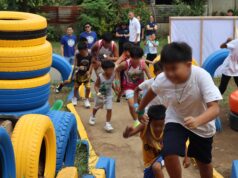CLARK FREEPORT – Orphans of journalists killed in the Maguindanao massacre last Nov. 23 have formed a group called Justice Now following moves of a non-government organization to heal their emotional and psychological scars.
This, even as psychologists reported that 70 percent of the children reported they have been having nightmares twice or thrice a week after their exposure to the tragic fate of their fathers in the massacre. Some of them were present when the bodies of their fathers were dug up.
But Sophia Flor Perez Garduce, officer-in-charge of the Sanlahi Alliance for Children’s Concerns (Sanlahi-ACC) told Punto! that such nightmares were expected.
Sanlahi-ACC has been conducting a “psycho-social profile” covering the children of journalists slain in the massacre. Her group, composed of seven psychologists and several social workers, was formed initially to provide counseling to families bereaved by the deaths of relatives during typhoon Ondoy in September last year. She was here over the weekend as seminar resource person of the Center for Media Freedom and Responsibility (CMFR).
Garduce said her group’s objectives for the families affected by the Maguindanao massacre were to “release the emotional stress” of the members of the bereaved family and acquaint them with each other for building a support system.”
She noted that the families who previously did not know each other, readily warmed up to the rest and even formed what they now call Justice Now which she described as a “self-help organization”.
Garduce said that despite this, the massacre has continued to inspire fear among the family members. “They did not want to extend our sessions because they did not want nighttime to catch up with their trip back home,” she said.
“Our limited resources enabled us to reach out to only the orphans of the journalists, although 57 persons died during the Maguindanao massacre. We have reached out to at least 20 families of the slain journalists who happened to be the lone breadwinners in their families, ” she said.
The group first held “sessions” with the families last Jan. 16 and 17 in General Santos City. Forty adults and 70 children expressed willingness to join the sessions, Garduce noted.
The children were grouped according to ages, the youngest grouping being from five to eight years old, she said.
Garduce also noted that some of the children were reported to have displayed “aggressiveness” in their schools through unprovoked violence. “When asked how they felt about such incidents, some replied: masarap ang pakiramdan (I felt good),” she said.
“Most of the children seem particularly anxious about family finances. With breadwinners of their families gone, they are worried so I think it is important to make them aware of any help being extended to their families,” she said.
Garduce also appealed to the teachers of the orphaned children. She received feedbacks that some of the children are being bullied around by their classmates in connection with the massacre, while some teachers are said to be inconsiderate when the affected children do not immediately respond to school requirements. “The school system must assist the children and their teachers must also understand the grief process,” she said.
Garduce also appealed to the elder relatives to help the children understand and accept reality, even as she urged them to let the children “stay in the school system to make them aware that life has to go on.”
“We will continue with group therapies for them. Next week, we will hold a case conference to find out who would need further individual therapies,” she said.
Garduce said her group expects to enter the “construction phase” of its work by this March. Under this phase, the family members are supposed to have “a deeper perception of what happened and its impact on themselves and their families.”
She said the next phase is supposed to be the “acceptance phase” which, she said, could be symbolized by the holding of the traditional Filipino “babang luksa” on the first year anniversary of the Maguindanao massacre on Nov. 23 this year.
This, even as psychologists reported that 70 percent of the children reported they have been having nightmares twice or thrice a week after their exposure to the tragic fate of their fathers in the massacre. Some of them were present when the bodies of their fathers were dug up.
But Sophia Flor Perez Garduce, officer-in-charge of the Sanlahi Alliance for Children’s Concerns (Sanlahi-ACC) told Punto! that such nightmares were expected.
Sanlahi-ACC has been conducting a “psycho-social profile” covering the children of journalists slain in the massacre. Her group, composed of seven psychologists and several social workers, was formed initially to provide counseling to families bereaved by the deaths of relatives during typhoon Ondoy in September last year. She was here over the weekend as seminar resource person of the Center for Media Freedom and Responsibility (CMFR).
Garduce said her group’s objectives for the families affected by the Maguindanao massacre were to “release the emotional stress” of the members of the bereaved family and acquaint them with each other for building a support system.”
She noted that the families who previously did not know each other, readily warmed up to the rest and even formed what they now call Justice Now which she described as a “self-help organization”.
Garduce said that despite this, the massacre has continued to inspire fear among the family members. “They did not want to extend our sessions because they did not want nighttime to catch up with their trip back home,” she said.
“Our limited resources enabled us to reach out to only the orphans of the journalists, although 57 persons died during the Maguindanao massacre. We have reached out to at least 20 families of the slain journalists who happened to be the lone breadwinners in their families, ” she said.
The group first held “sessions” with the families last Jan. 16 and 17 in General Santos City. Forty adults and 70 children expressed willingness to join the sessions, Garduce noted.
The children were grouped according to ages, the youngest grouping being from five to eight years old, she said.
Garduce also noted that some of the children were reported to have displayed “aggressiveness” in their schools through unprovoked violence. “When asked how they felt about such incidents, some replied: masarap ang pakiramdan (I felt good),” she said.
“Most of the children seem particularly anxious about family finances. With breadwinners of their families gone, they are worried so I think it is important to make them aware of any help being extended to their families,” she said.
Garduce also appealed to the teachers of the orphaned children. She received feedbacks that some of the children are being bullied around by their classmates in connection with the massacre, while some teachers are said to be inconsiderate when the affected children do not immediately respond to school requirements. “The school system must assist the children and their teachers must also understand the grief process,” she said.
Garduce also appealed to the elder relatives to help the children understand and accept reality, even as she urged them to let the children “stay in the school system to make them aware that life has to go on.”
“We will continue with group therapies for them. Next week, we will hold a case conference to find out who would need further individual therapies,” she said.
Garduce said her group expects to enter the “construction phase” of its work by this March. Under this phase, the family members are supposed to have “a deeper perception of what happened and its impact on themselves and their families.”
She said the next phase is supposed to be the “acceptance phase” which, she said, could be symbolized by the holding of the traditional Filipino “babang luksa” on the first year anniversary of the Maguindanao massacre on Nov. 23 this year.




